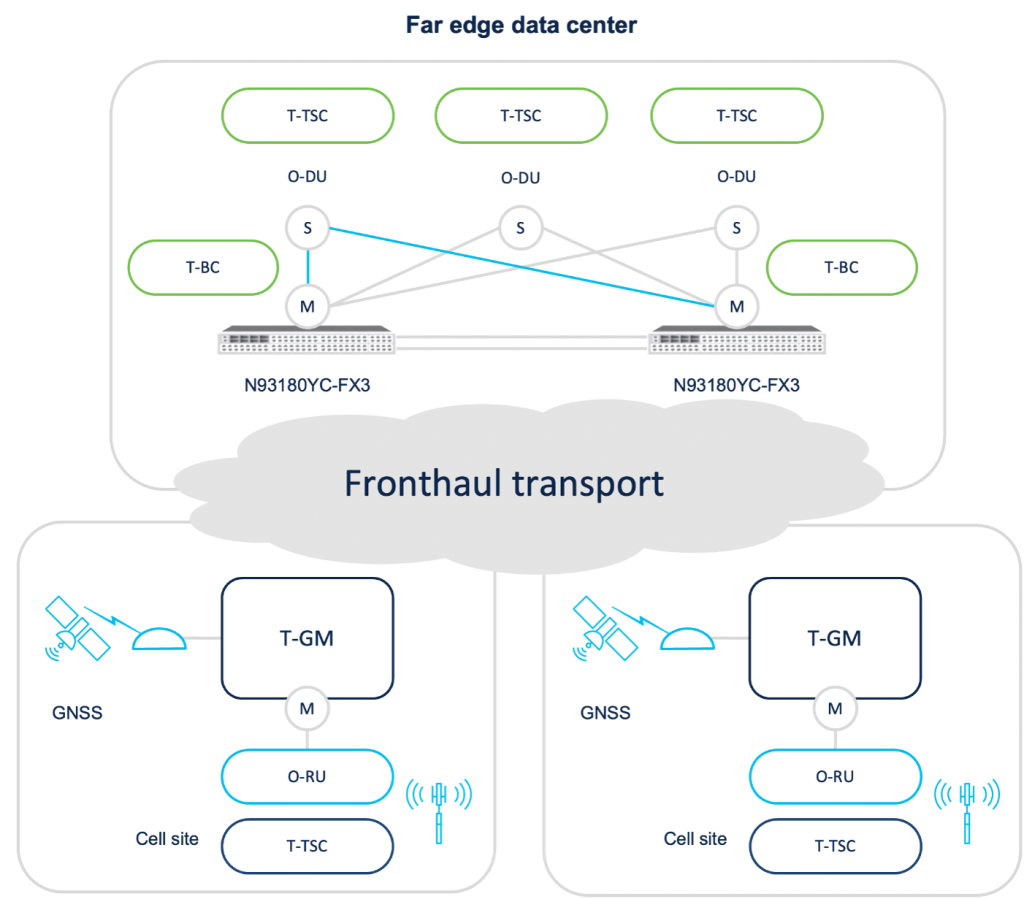Cisco and Intel validate interoperability between Cisco Nexus 93180YC-FX3 Switch and Intel® Ethernet 800 Series Network Adapters that feature enhanced timing capabilities for faster and lower cost Open RAN (Radio Access Networks) deployments.
The emergence of Open RAN (O-RAN) standards and solutions is based on the virtualization of network functions and a multi-vendor ecosystem to grow innovation while driving down 5G network operation costs. But an open ecosystem requires each network element to communicate and interoperate with the others. Cisco and Intel have collaborated on a network solution for communications service providers (CoSPs) that delivers on the O-RAN promise.
To address integration challenges faced by CoSPs when deploying Open RAN network infrastructure, Cisco and Intel have combined forces to validate seamless interoperability between Intel® Ethernet 800 Series Network Adapters with enhanced network timing capabilities and Cisco Nexus 93180YC-FX3 network switches.
The Promise of Open RAN
Radio access networks (RANs) historically have been built from proprietary equipment and systems that relied on hardware-centric, centralized, single-vendor components. These systems locked CoSPs into specific vendors and costly integrations, often limiting their ability to scale and innovate. The O-RAN set of standards specifies open, intelligent, virtualized, and fully interoperable RANs supported by multi-vendor interoperability, with a scalable, secure, cloud-native infrastructure that enables service delivery to the network edge, closer to the user.
Solution disaggregation and the use of open interfaces opened the door for the first time for commercial-off-the-shelf (COTS) servers, routers and other networking equipment. But it also increased the need for interoperability between network systems.
One area where this is critical is fronthaul synchronization (Figure 1). The fronthaul in 5G networks is part of cloud-based RAN connecting standalone radio units (RUs) and distributed units (DUs) installed at remote cell sites with centralized units (CUs) that can aggregate multiple DUs and exist in the cloud. This architecture pushes compute power to the network edge and enables support for applications that require high bandwidth and extremely low latency.

Fronthaul synchronization involves the network adapter and the network switch to ensure that data packet order is accurate, secure, and consistently delivered between data source and endpoints without data loss or corruption so that products from different vendors can seamlessly communicate.
The synchronization plane (S-Plane) controls timing and synchronization between the DU and the RU, and highly accurate timing and synchronization is required for processes such as multiple input/multiple output (MIMO), time-division duplexing (TDD), and carrier aggregation of multiple O-RUs.

Validated Interoperability
In this application (Figure 3), interoperability needs to be considered for these S-Plane functions. To address interoperability challenges faced by CoSPs when deploying Open RAN network infrastructure, Cisco and Intel have combined forces to verify interoperability between Intel Ethernet Network Adapter E810-XXVDA4T and Cisco Nexus 93180YC-FX3 network switches.
This collaboration is part of Intel’s interoperability verification program, which features a dedicated Intel lab that evaluates Intel Ethernet 800 Series Network Adapters connected to a wide range of media types and Ethernet switches. The goal of the interoperability verification program is to test and ensure compliance to IEEE standards and also to quality-assure the PHY functionality of Intel Ethernet Network Adapters.
Cisco and Intel successfully performed the following tests:
- Test 1: Cisco Nexus 93180YC-FX3 Switch and the Intel Ethernet Network Adapter E810-XXVDA4T successfully passed 25Gbps line rate radio traffic.
- Test 2: Clocking features such as 1588 PTP Telcom Profile 8275.1 and frequency synchronization (SyncE) demonstrated.
- Test 3: Clock received by virtual DU over the network using 1588 PTP and SyncE.

Result: Through this verification and quality assurance of interoperability, Intel and Cisco have worked closely to simplify platform integrations and accelerate validation and deployment to deliver a solution that assures ease of integration for Open RAN deployments. Intel and Cisco plan to continue these interoperability tests with upcoming products from both companies.
Conclusion
Cisco and Intel have a long history of collaboration and their commitment to interoperability for CoSP applications is showcased in their tight integration of network adapters and switch solutions for Open RAN applications eased deployments, faster time-to-market, lower total cost of ownership, and scalability and customizability for CoSPs committed to the advantages of O-RAN.
Check out Intel’s Solution Overview on the collaboration and more
We’d love to hear what you think. Ask a Question, Comment Below, and Stay Connected with #CiscoPartners on social!
Cisco Partners Facebook | @CiscoPartners Twitter | Cisco Partners LinkedIn
Great to see this validated interoperability, nice blog